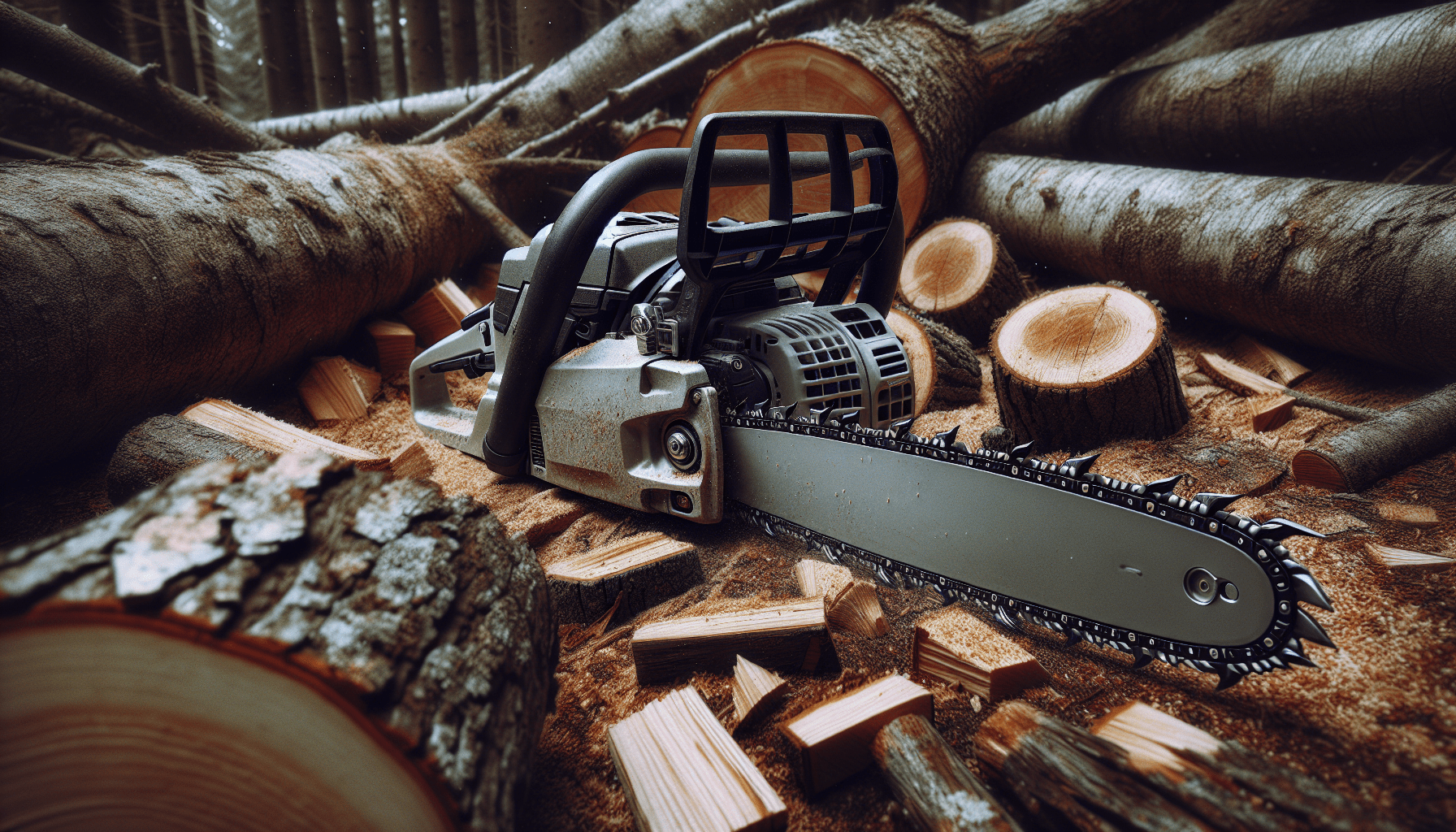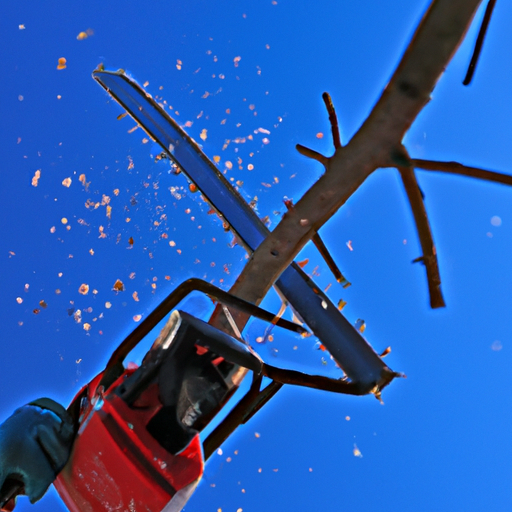Have you ever wondered just how common chainsaw accidents really are? From horror movie scenes to real-life incidents, chainsaws have gained a reputation for being dangerous and potentially deadly. In this article, we will take a closer look at the frequency of chainsaw accidents and explore the importance of safety measures when handling these powerful tools. Brace yourself for some eye-opening statistics and valuable insights into this often overlooked aspect of the woodworking world. So, put on your safety goggles and let’s get started!
Overview of Chainsaw Accidents
Chainsaw accidents can occur in a wide range of settings, from professional tree-cutting operations to DIY projects in the backyard. These accidents can result in serious injuries and even fatalities. In this article, we will explore the statistics, types of accidents, common injuries, causes, prevention and safety measures, legal and financial consequences, industry regulations, case studies, safety training programs, promoting safety awareness, accident compensation, and the importance of chainsaw safety.
Statistics on Chainsaw Accidents
Chainsaw accidents unfortunately happen more frequently than we might think. According to data from the Occupational Safety and Health Administration (OSHA), there are approximately 36,000 chainsaw-related injuries in the United States each year. These accidents often result in severe injuries, such as lacerations, amputations, fractures, and even death. It is essential to understand these statistics to recognize the importance of chainsaw accident prevention.
Types of Chainsaw Accidents
Chainsaw accidents can occur in various ways, each presenting its own set of dangers. Some common types of chainsaw accidents include kickback incidents, chainsaw blade contact injuries, projectile injuries, and accidents when starting or refueling the chainsaw. Understanding these different types of accidents can help identify potential hazards and implement appropriate safety measures.
Common Injuries Related to Chainsaw Accidents
Chainsaw accidents can lead to a wide variety of injuries, many of which can be severe and life-altering. Lacerations are among the most common injuries, as the sharp chainsaw blade can easily cut through skin, muscles, and bones. Amputations, fractures, and deep tissue injuries are also prevalent. In some cases, chainsaw accidents can cause severe internal injuries and damage to vital organs. It is crucial to prioritize safety to prevent such injuries.
Causes of Chainsaw Accidents
Understanding the underlying causes of chainsaw accidents is crucial for preventing them in the first place. Several factors contribute to the occurrence of these accidents, including:
Lack of Proper Training and Experience
One significant cause of chainsaw accidents is a lack of proper training and experience. Operating a chainsaw requires specific skills and knowledge to use it safely and effectively. Without adequate training, individuals may lack the necessary understanding of operating procedures, safety precautions, and emergency procedures. Proper training and certification programs can help mitigate this risk.
Insufficient Safety Precautions
Another cause of chainsaw accidents is the failure to implement sufficient safety precautions. This can include not wearing appropriate protective gear, such as chainsaw chaps, gloves, helmet, and eye and ear protection. Additionally, failure to establish a safe work environment, such as clearing the area of potential hazards, can also contribute to accidents.
Equipment Malfunctions
Equipment malfunctions are another common cause of chainsaw accidents. This can include issues such as faulty chains, poorly maintained chainsaws, or defective safety mechanisms. Regular maintenance and inspections are crucial to ensure that chainsaws are in proper working condition and reduce the risk of accidents.
Fatigue and Distraction
Fatigue and distraction can greatly increase the likelihood of chainsaw accidents. Operating a chainsaw requires focus and attention to detail. Fatigue can impair judgment and reaction time, while distractions can divert attention away from the task at hand. It is important to get enough rest and maintain focus while operating a chainsaw to minimize the risk of accidents.
Prevention and Safety Measures
Preventing chainsaw accidents requires a comprehensive approach that addresses the underlying causes and implements proactive safety measures. Some key prevention and safety measures include:
Proper Training and Certification
Empowering individuals with proper chainsaw training and certification is crucial for accident prevention. Training programs provide valuable knowledge and skills in safe chainsaw operation, maintenance, and emergency procedures. Certification ensures that individuals are adequately prepared to handle chainsaws and reduces the risk of accidents.
Wearing Protective Gear
Wearing appropriate protective gear is essential for minimizing the severity of injuries in the event of an accident. This gear includes chainsaw chaps, gloves, helmet with face shield and hearing protection, and safety boots. Investing in high-quality protective gear and wearing it consistently can significantly enhance safety.
Regular Maintenance and Inspections
Regular maintenance and inspections of chainsaws are vital to identify any potential issues and ensure the equipment is in good working condition. This includes checking the chain tension, sharpening the blade, and inspecting safety features such as the chain brake and throttle lockout. By diligently maintaining and inspecting chainsaws, the risk of equipment malfunctions can be greatly reduced.
Safe Operating Practices
Following safe operating practices is critical to prevent chainsaw accidents. This includes techniques such as maintaining a firm grip on the chainsaw, positioning the body properly while cutting, and using the appropriate cutting techniques for different types of wood. Adhering to recommended operating practices significantly reduces the likelihood of accidents.
Creating a Safe Work Environment
Establishing a safe work environment is essential for preventing chainsaw accidents. Clear the work area of potential hazards, including fallen branches, rocks, or uneven terrain. Maintain a safe distance from bystanders, and ensure that nobody is standing in the “kickback zone.” By creating a safe work environment, the risk of accidents can be significantly minimized.
Legal and Financial Consequences
Chainsaw accidents not only result in physical harm but can also have legal and financial implications. Individuals and businesses may face various consequences depending on the circumstances of the accident. Some potential legal and financial consequences include:
Worker’s Compensation Claims
If a chainsaw accident occurs while working, employees may be eligible for worker’s compensation benefits. These benefits can cover medical expenses, lost wages, and rehabilitation costs. Worker’s compensation claims can provide the necessary support to individuals injured in chainsaw accidents.
Personal Injury Lawsuits
In cases where negligence or product liability is involved, injured individuals may choose to pursue personal injury lawsuits. These lawsuits seek compensation for damages such as medical expenses, pain and suffering, and lost earning capacity. Personal injury lawsuits can hold responsible parties accountable and provide financial relief for victims.
Potential Fines and Penalties for Safety Violations
Businesses and individuals who fail to comply with safety regulations and guidelines may be subject to fines and penalties. Government agencies such as OSHA may investigate chainsaw accidents and determine whether safety violations occurred. Depending on the severity of the violations, fines and penalties can be imposed, reinforcing the importance of adhering to safety standards.
Industry Regulations and Standards
To ensure chainsaw safety, there are industry regulations and standards in place that individuals and organizations must adhere to. These regulations help establish guidelines for safe chainsaw operation and encourage the adoption of best practices. Some key organizations and regulations include:
Occupational Safety and Health Administration (OSHA) Guidelines
OSHA provides regulations, guidelines, and resources to promote workplace safety, including the safe use of chainsaws. These guidelines cover topics such as personal protective equipment, training requirements, and hazard assessment. Adhering to OSHA guidelines is essential for maintaining a safe work environment and preventing accidents.
National Fire Protection Association (NFPA) Standards
The NFPA develops standards for various industries, including chainsaw safety. These standards aim to ensure that individuals working with chainsaws have access to the necessary protective equipment and follow safe operating practices. Adhering to NFPA standards helps reduce the risk of accidents and promotes a culture of safety.
Case Studies and Real-Life Examples
Examining case studies and real-life examples of chainsaw accidents can provide valuable insights and lessons learned. By understanding the specific circumstances and causes of previous accidents, individuals and organizations can identify potential hazards and implement appropriate preventive measures. Some notable chainsaw accidents and tragedies serve as reminders of the importance of chainsaw safety.
Notable Chainsaw Accidents and Tragedies
One notable chainsaw accident occurred in 2010 when a professional tree cutter suffered severe injuries from a chainsaw kickback incident. Due to the lack of proper protective gear and insufficient safety precautions, the worker experienced deep lacerations and required extensive medical treatment. This incident highlights the need for proactive safety measures to prevent such accidents.
Lessons Learned from Past Incidents
Many past chainsaw accidents underscore the importance of proper training, wearing protective gear, and maintaining equipment. By analyzing these incidents, lessons can be learned regarding safe operating practices, creating a safe work environment, and understanding the potential consequences of neglecting safety precautions. These lessons should be applied to improve chainsaw safety moving forward.
Chainsaw Safety Training Programs
To address the need for chainsaw safety education, various training programs and courses are available. These programs aim to equip individuals with the necessary knowledge and skills to operate chainsaws safely. Participating in safety training offers numerous benefits for both professionals and DIY enthusiasts.
Available Training Programs and Courses
There are several reputable chainsaw safety training programs available, including those offered by professional organizations, vocational schools, and online platforms. These programs cover topics such as chainsaw operation, maintenance, emergency procedures, and safety precautions. It is crucial to choose a program that aligns with individual needs and requirements.
Benefits of Participating in Safety Training
Participating in chainsaw safety training provides individuals with invaluable knowledge and skills to ensure their safety and the safety of others. Training programs cover essential aspects such as understanding chainsaw mechanics, recognizing potential hazards, and employing proper safety procedures. By participating in safety training, individuals can enhance their competence and confidence in operating chainsaws.
Promoting Chainsaw Safety Awareness
Promoting chainsaw safety awareness is a vital step in preventing accidents and minimizing injuries. Educational campaigns and outreach programs play a significant role in raising awareness and fostering a culture of safety.
Educational Campaigns and Outreach Programs
Educational campaigns organized by government agencies, non-profit organizations, and industry stakeholders help disseminate important chainsaw safety information to the public. These campaigns often include public service announcements, workshops, and safety demonstrations to educate individuals about the dangers of chainsaw accidents and the importance of safety precautions.
Collaboration with Industry Organizations and Associations
Collaborating with industry organizations and associations is crucial for promoting chainsaw safety awareness. By working together, these groups can develop and disseminate best practices, provide resources and training, and advocate for improved safety standards. Such collaborations strengthen the collective effort to prevent chainsaw accidents and promote a safer working environment.
Chainsaw Accident Compensation
In the unfortunate event of a chainsaw accident, understanding the process of seeking compensation is essential for individuals suffering from injuries and financial losses.
Navigating the Insurance Claims Process
Individuals injured in chainsaw accidents may need to navigate the insurance claims process to obtain compensation for their medical expenses and other damages. This process involves filing a claim with the responsible party’s insurance company, providing necessary documentation, and working with adjusters to settle the claim. Understanding the process and seeking professional advice can help victims navigate the complexities of insurance claims.
Seeking Legal Advice and Representation
In some cases, individuals may need to seek legal advice and representation to pursue compensation through personal injury lawsuits. Consulting with an experienced personal injury attorney can help injured individuals understand their rights, assess the merits of their case, and navigate the legal system to seek appropriate compensation. Legal representation can ensure that victims receive the compensation they deserve.
Conclusion and Call to Action
Chainsaw accidents are unfortunately common and can result in devastating injuries and financial consequences. However, by understanding the statistics, types of accidents, common injuries, causes, prevention and safety measures, legal and financial consequences, industry regulations, case studies, safety training programs, promoting safety awareness, accident compensation, and the importance of chainsaw safety, individuals and organizations can take proactive steps to prevent these accidents. By prioritizing proper training, safety precautions, and maintaining equipment, we can create a safer environment and reduce the risk of chainsaw accidents. Remember, safety should always be the top priority in any chainsaw operation. Let’s work together to keep ourselves and others safe.



